Nursing Best Practices for Pain Assessment of Intubated ICU Patients
VerifiedAdded on 2020/05/16
|11
|2752
|91
Report
AI Summary
This report focuses on the critical evaluation of nursing best practices for pain assessment in intubated patients within the Intensive Care Unit (ICU) setting. The report begins with an executive summary highlighting the challenges of pain assessment in critically ill patients, particularly those under intubation. The introduction establishes the importance of effective pain management and the rationale for selecting this topic. The core of the report comprises a critical evaluation of three research articles, analyzing their methodologies, findings, strengths, and limitations. The study by Ayasrah et al. (2014) is evaluated for its focus on pain indicators, while Varndell, Fry & Elliott (2017)'s systematic review examines pain instruments for non-verbal patients. Rijkenberg et al. (2015)'s cohort study compares the CPOT and BPS tools. The discussion then transitions into a critical observation based on the student's clinical placement, detailing a scenario where the CPOT tool was used to assess pain in post-operative ICU patients. The report concludes by emphasizing the significance of the CPOT tool in assessing pain among critically ill, intubated patients and its role in guiding appropriate pain management interventions. References to the articles are provided.

Running head- NURSING ASSIGNMENT
Nursing best practice for the assessment of pain for intubated patients in ICU
Name of the Student
Name of the University
Author Note
Nursing best practice for the assessment of pain for intubated patients in ICU
Name of the Student
Name of the University
Author Note
Paraphrase This Document
Need a fresh take? Get an instant paraphrase of this document with our AI Paraphraser
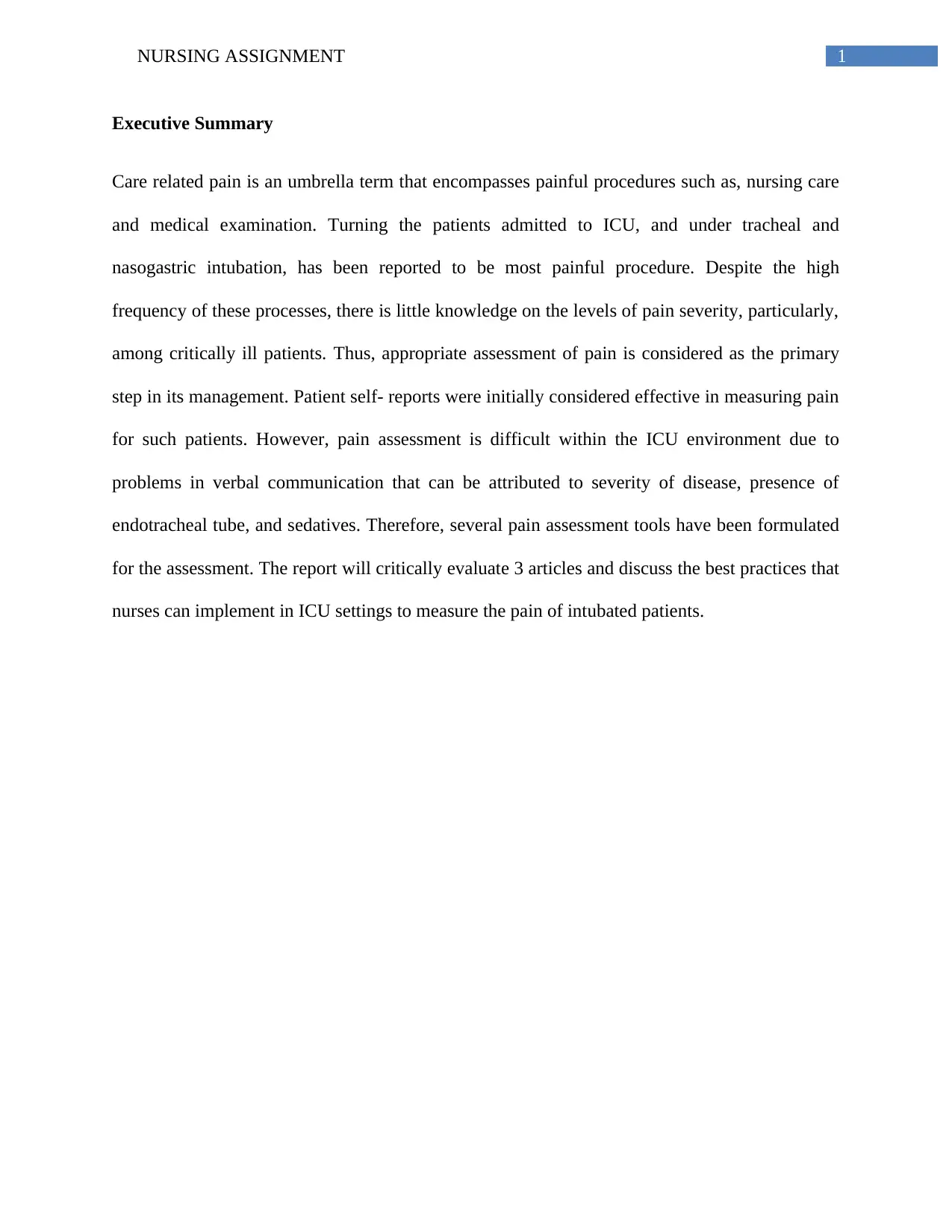
1NURSING ASSIGNMENT
Executive Summary
Care related pain is an umbrella term that encompasses painful procedures such as, nursing care
and medical examination. Turning the patients admitted to ICU, and under tracheal and
nasogastric intubation, has been reported to be most painful procedure. Despite the high
frequency of these processes, there is little knowledge on the levels of pain severity, particularly,
among critically ill patients. Thus, appropriate assessment of pain is considered as the primary
step in its management. Patient self- reports were initially considered effective in measuring pain
for such patients. However, pain assessment is difficult within the ICU environment due to
problems in verbal communication that can be attributed to severity of disease, presence of
endotracheal tube, and sedatives. Therefore, several pain assessment tools have been formulated
for the assessment. The report will critically evaluate 3 articles and discuss the best practices that
nurses can implement in ICU settings to measure the pain of intubated patients.
Executive Summary
Care related pain is an umbrella term that encompasses painful procedures such as, nursing care
and medical examination. Turning the patients admitted to ICU, and under tracheal and
nasogastric intubation, has been reported to be most painful procedure. Despite the high
frequency of these processes, there is little knowledge on the levels of pain severity, particularly,
among critically ill patients. Thus, appropriate assessment of pain is considered as the primary
step in its management. Patient self- reports were initially considered effective in measuring pain
for such patients. However, pain assessment is difficult within the ICU environment due to
problems in verbal communication that can be attributed to severity of disease, presence of
endotracheal tube, and sedatives. Therefore, several pain assessment tools have been formulated
for the assessment. The report will critically evaluate 3 articles and discuss the best practices that
nurses can implement in ICU settings to measure the pain of intubated patients.
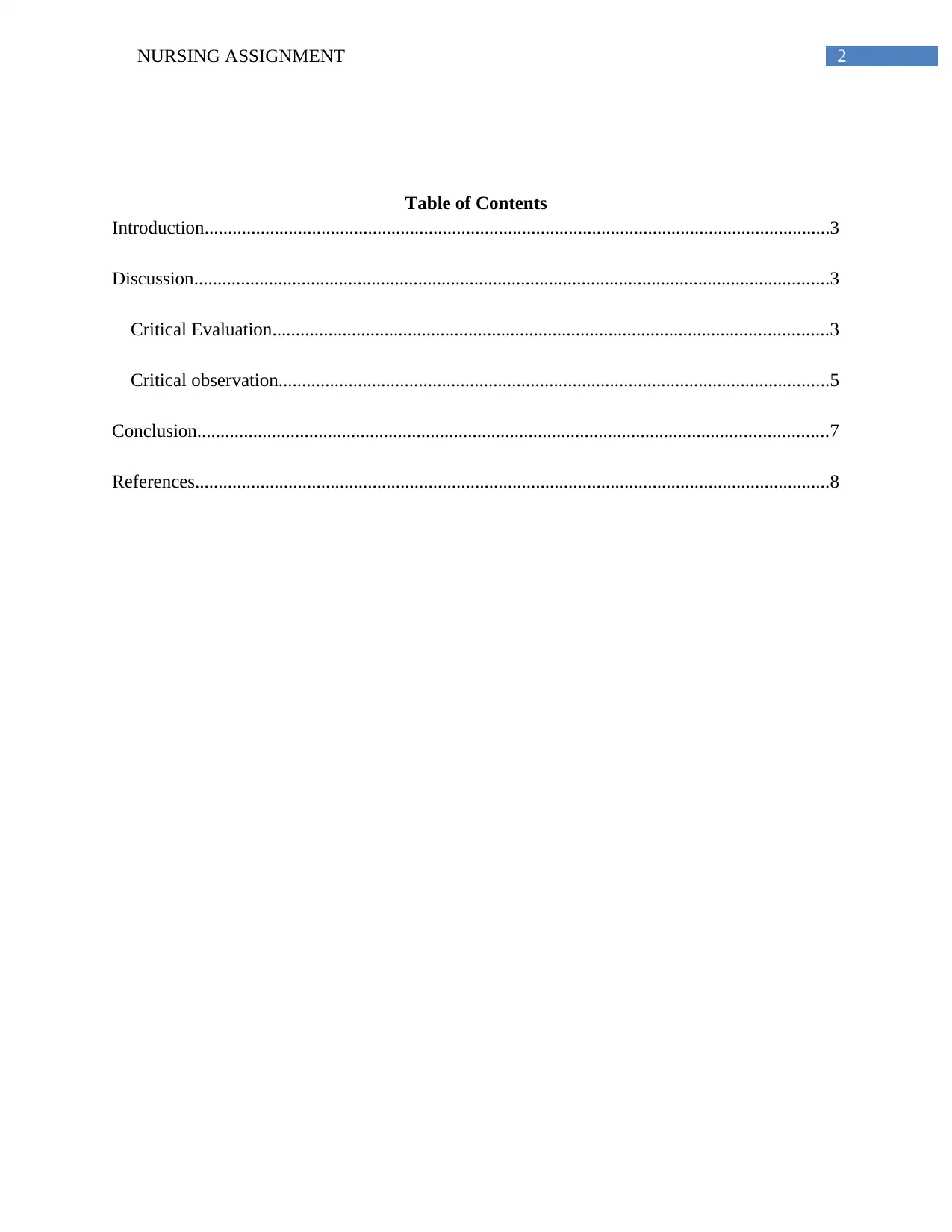
2NURSING ASSIGNMENT
Table of Contents
Introduction......................................................................................................................................3
Discussion........................................................................................................................................3
Critical Evaluation.......................................................................................................................3
Critical observation......................................................................................................................5
Conclusion.......................................................................................................................................7
References........................................................................................................................................8
Table of Contents
Introduction......................................................................................................................................3
Discussion........................................................................................................................................3
Critical Evaluation.......................................................................................................................3
Critical observation......................................................................................................................5
Conclusion.......................................................................................................................................7
References........................................................................................................................................8
⊘ This is a preview!⊘
Do you want full access?
Subscribe today to unlock all pages.

Trusted by 1+ million students worldwide
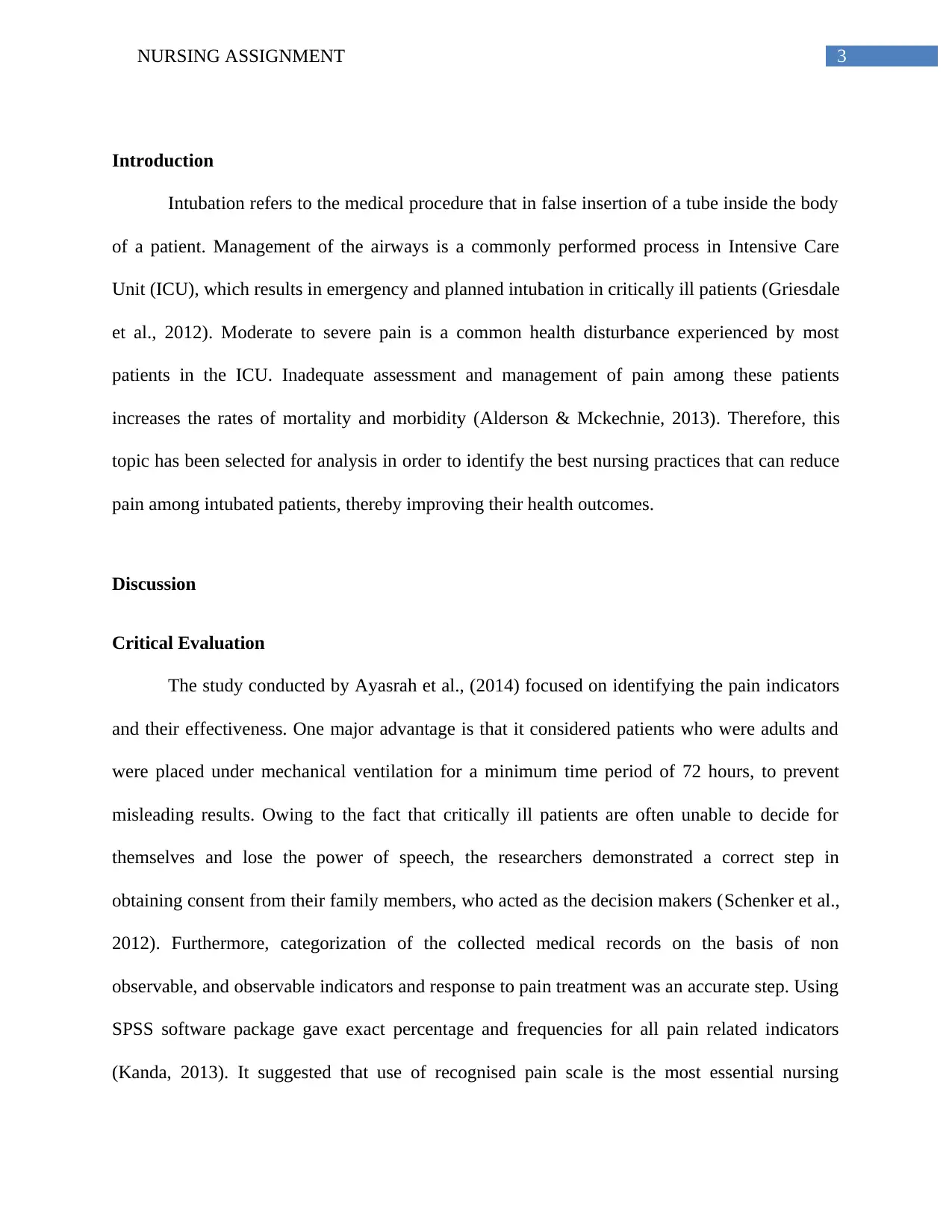
3NURSING ASSIGNMENT
Introduction
Intubation refers to the medical procedure that in false insertion of a tube inside the body
of a patient. Management of the airways is a commonly performed process in Intensive Care
Unit (ICU), which results in emergency and planned intubation in critically ill patients (Griesdale
et al., 2012). Moderate to severe pain is a common health disturbance experienced by most
patients in the ICU. Inadequate assessment and management of pain among these patients
increases the rates of mortality and morbidity (Alderson & Mckechnie, 2013). Therefore, this
topic has been selected for analysis in order to identify the best nursing practices that can reduce
pain among intubated patients, thereby improving their health outcomes.
Discussion
Critical Evaluation
The study conducted by Ayasrah et al., (2014) focused on identifying the pain indicators
and their effectiveness. One major advantage is that it considered patients who were adults and
were placed under mechanical ventilation for a minimum time period of 72 hours, to prevent
misleading results. Owing to the fact that critically ill patients are often unable to decide for
themselves and lose the power of speech, the researchers demonstrated a correct step in
obtaining consent from their family members, who acted as the decision makers (Schenker et al.,
2012). Furthermore, categorization of the collected medical records on the basis of non
observable, and observable indicators and response to pain treatment was an accurate step. Using
SPSS software package gave exact percentage and frequencies for all pain related indicators
(Kanda, 2013). It suggested that use of recognised pain scale is the most essential nursing
Introduction
Intubation refers to the medical procedure that in false insertion of a tube inside the body
of a patient. Management of the airways is a commonly performed process in Intensive Care
Unit (ICU), which results in emergency and planned intubation in critically ill patients (Griesdale
et al., 2012). Moderate to severe pain is a common health disturbance experienced by most
patients in the ICU. Inadequate assessment and management of pain among these patients
increases the rates of mortality and morbidity (Alderson & Mckechnie, 2013). Therefore, this
topic has been selected for analysis in order to identify the best nursing practices that can reduce
pain among intubated patients, thereby improving their health outcomes.
Discussion
Critical Evaluation
The study conducted by Ayasrah et al., (2014) focused on identifying the pain indicators
and their effectiveness. One major advantage is that it considered patients who were adults and
were placed under mechanical ventilation for a minimum time period of 72 hours, to prevent
misleading results. Owing to the fact that critically ill patients are often unable to decide for
themselves and lose the power of speech, the researchers demonstrated a correct step in
obtaining consent from their family members, who acted as the decision makers (Schenker et al.,
2012). Furthermore, categorization of the collected medical records on the basis of non
observable, and observable indicators and response to pain treatment was an accurate step. Using
SPSS software package gave exact percentage and frequencies for all pain related indicators
(Kanda, 2013). It suggested that use of recognised pain scale is the most essential nursing
Paraphrase This Document
Need a fresh take? Get an instant paraphrase of this document with our AI Paraphraser
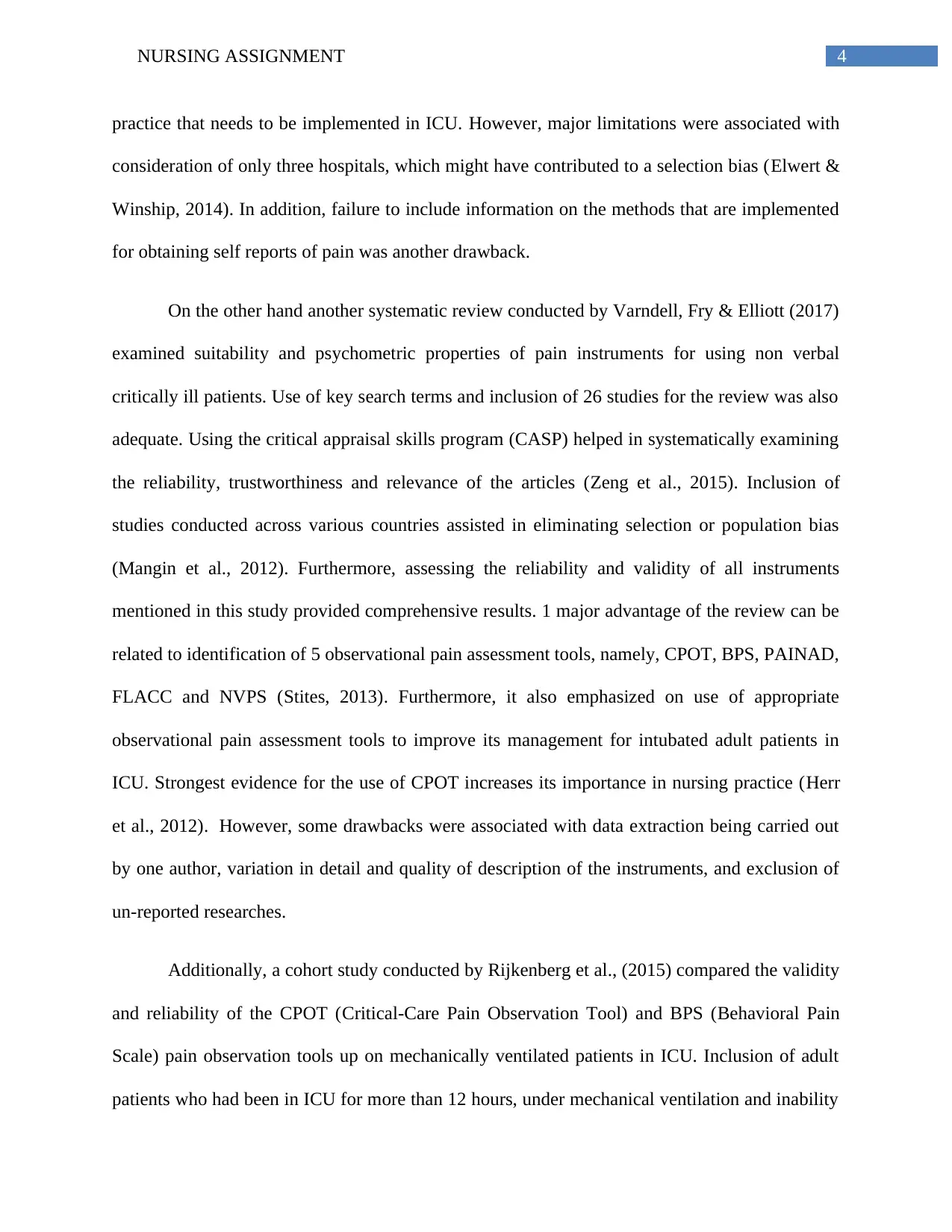
4NURSING ASSIGNMENT
practice that needs to be implemented in ICU. However, major limitations were associated with
consideration of only three hospitals, which might have contributed to a selection bias (Elwert &
Winship, 2014). In addition, failure to include information on the methods that are implemented
for obtaining self reports of pain was another drawback.
On the other hand another systematic review conducted by Varndell, Fry & Elliott (2017)
examined suitability and psychometric properties of pain instruments for using non verbal
critically ill patients. Use of key search terms and inclusion of 26 studies for the review was also
adequate. Using the critical appraisal skills program (CASP) helped in systematically examining
the reliability, trustworthiness and relevance of the articles (Zeng et al., 2015). Inclusion of
studies conducted across various countries assisted in eliminating selection or population bias
(Mangin et al., 2012). Furthermore, assessing the reliability and validity of all instruments
mentioned in this study provided comprehensive results. 1 major advantage of the review can be
related to identification of 5 observational pain assessment tools, namely, CPOT, BPS, PAINAD,
FLACC and NVPS (Stites, 2013). Furthermore, it also emphasized on use of appropriate
observational pain assessment tools to improve its management for intubated adult patients in
ICU. Strongest evidence for the use of CPOT increases its importance in nursing practice (Herr
et al., 2012). However, some drawbacks were associated with data extraction being carried out
by one author, variation in detail and quality of description of the instruments, and exclusion of
un-reported researches.
Additionally, a cohort study conducted by Rijkenberg et al., (2015) compared the validity
and reliability of the CPOT (Critical-Care Pain Observation Tool) and BPS (Behavioral Pain
Scale) pain observation tools up on mechanically ventilated patients in ICU. Inclusion of adult
patients who had been in ICU for more than 12 hours, under mechanical ventilation and inability
practice that needs to be implemented in ICU. However, major limitations were associated with
consideration of only three hospitals, which might have contributed to a selection bias (Elwert &
Winship, 2014). In addition, failure to include information on the methods that are implemented
for obtaining self reports of pain was another drawback.
On the other hand another systematic review conducted by Varndell, Fry & Elliott (2017)
examined suitability and psychometric properties of pain instruments for using non verbal
critically ill patients. Use of key search terms and inclusion of 26 studies for the review was also
adequate. Using the critical appraisal skills program (CASP) helped in systematically examining
the reliability, trustworthiness and relevance of the articles (Zeng et al., 2015). Inclusion of
studies conducted across various countries assisted in eliminating selection or population bias
(Mangin et al., 2012). Furthermore, assessing the reliability and validity of all instruments
mentioned in this study provided comprehensive results. 1 major advantage of the review can be
related to identification of 5 observational pain assessment tools, namely, CPOT, BPS, PAINAD,
FLACC and NVPS (Stites, 2013). Furthermore, it also emphasized on use of appropriate
observational pain assessment tools to improve its management for intubated adult patients in
ICU. Strongest evidence for the use of CPOT increases its importance in nursing practice (Herr
et al., 2012). However, some drawbacks were associated with data extraction being carried out
by one author, variation in detail and quality of description of the instruments, and exclusion of
un-reported researches.
Additionally, a cohort study conducted by Rijkenberg et al., (2015) compared the validity
and reliability of the CPOT (Critical-Care Pain Observation Tool) and BPS (Behavioral Pain
Scale) pain observation tools up on mechanically ventilated patients in ICU. Inclusion of adult
patients who had been in ICU for more than 12 hours, under mechanical ventilation and inability
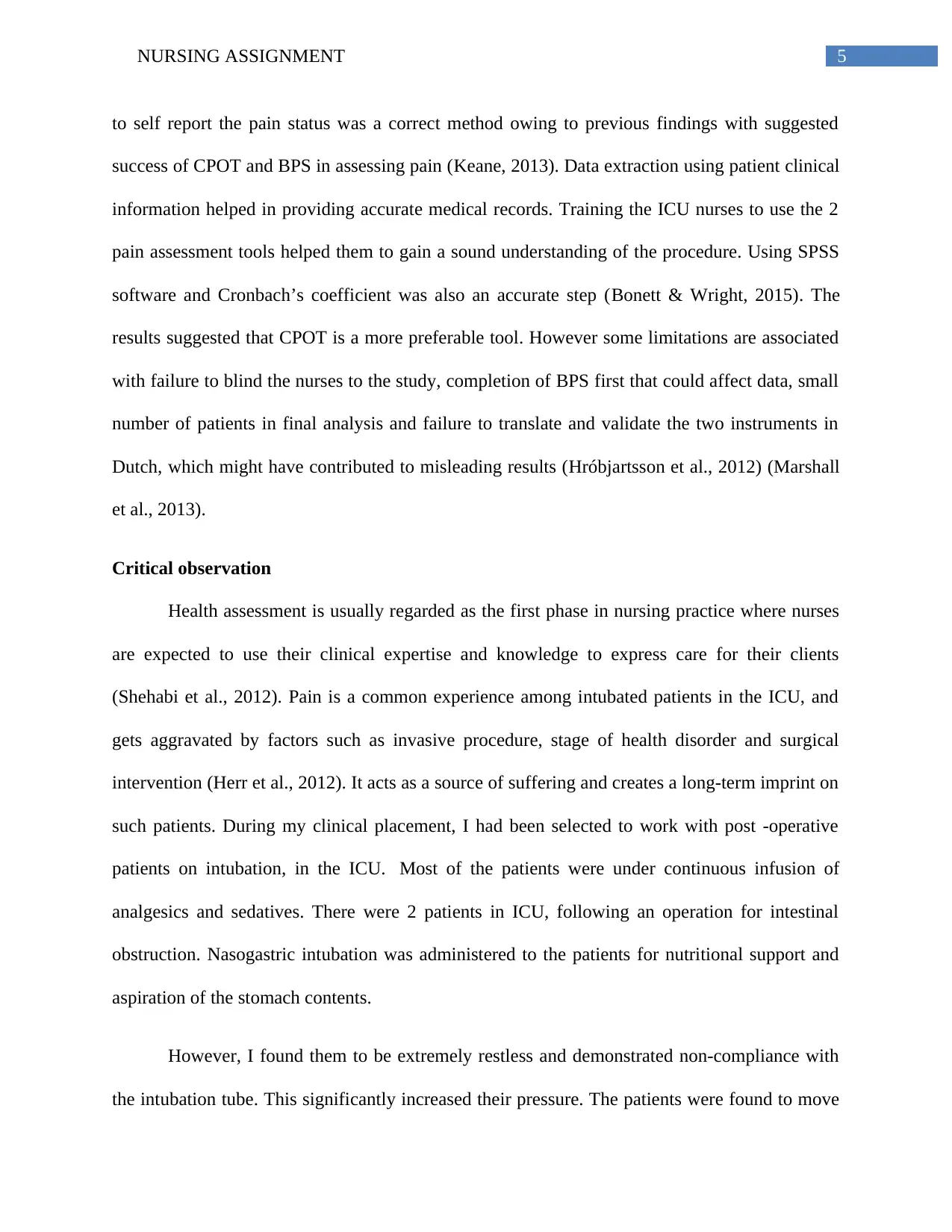
5NURSING ASSIGNMENT
to self report the pain status was a correct method owing to previous findings with suggested
success of CPOT and BPS in assessing pain (Keane, 2013). Data extraction using patient clinical
information helped in providing accurate medical records. Training the ICU nurses to use the 2
pain assessment tools helped them to gain a sound understanding of the procedure. Using SPSS
software and Cronbach’s coefficient was also an accurate step (Bonett & Wright, 2015). The
results suggested that CPOT is a more preferable tool. However some limitations are associated
with failure to blind the nurses to the study, completion of BPS first that could affect data, small
number of patients in final analysis and failure to translate and validate the two instruments in
Dutch, which might have contributed to misleading results (Hróbjartsson et al., 2012) (Marshall
et al., 2013).
Critical observation
Health assessment is usually regarded as the first phase in nursing practice where nurses
are expected to use their clinical expertise and knowledge to express care for their clients
(Shehabi et al., 2012). Pain is a common experience among intubated patients in the ICU, and
gets aggravated by factors such as invasive procedure, stage of health disorder and surgical
intervention (Herr et al., 2012). It acts as a source of suffering and creates a long-term imprint on
such patients. During my clinical placement, I had been selected to work with post -operative
patients on intubation, in the ICU. Most of the patients were under continuous infusion of
analgesics and sedatives. There were 2 patients in ICU, following an operation for intestinal
obstruction. Nasogastric intubation was administered to the patients for nutritional support and
aspiration of the stomach contents.
However, I found them to be extremely restless and demonstrated non-compliance with
the intubation tube. This significantly increased their pressure. The patients were found to move
to self report the pain status was a correct method owing to previous findings with suggested
success of CPOT and BPS in assessing pain (Keane, 2013). Data extraction using patient clinical
information helped in providing accurate medical records. Training the ICU nurses to use the 2
pain assessment tools helped them to gain a sound understanding of the procedure. Using SPSS
software and Cronbach’s coefficient was also an accurate step (Bonett & Wright, 2015). The
results suggested that CPOT is a more preferable tool. However some limitations are associated
with failure to blind the nurses to the study, completion of BPS first that could affect data, small
number of patients in final analysis and failure to translate and validate the two instruments in
Dutch, which might have contributed to misleading results (Hróbjartsson et al., 2012) (Marshall
et al., 2013).
Critical observation
Health assessment is usually regarded as the first phase in nursing practice where nurses
are expected to use their clinical expertise and knowledge to express care for their clients
(Shehabi et al., 2012). Pain is a common experience among intubated patients in the ICU, and
gets aggravated by factors such as invasive procedure, stage of health disorder and surgical
intervention (Herr et al., 2012). It acts as a source of suffering and creates a long-term imprint on
such patients. During my clinical placement, I had been selected to work with post -operative
patients on intubation, in the ICU. Most of the patients were under continuous infusion of
analgesics and sedatives. There were 2 patients in ICU, following an operation for intestinal
obstruction. Nasogastric intubation was administered to the patients for nutritional support and
aspiration of the stomach contents.
However, I found them to be extremely restless and demonstrated non-compliance with
the intubation tube. This significantly increased their pressure. The patients were found to move
⊘ This is a preview!⊘
Do you want full access?
Subscribe today to unlock all pages.

Trusted by 1+ million students worldwide
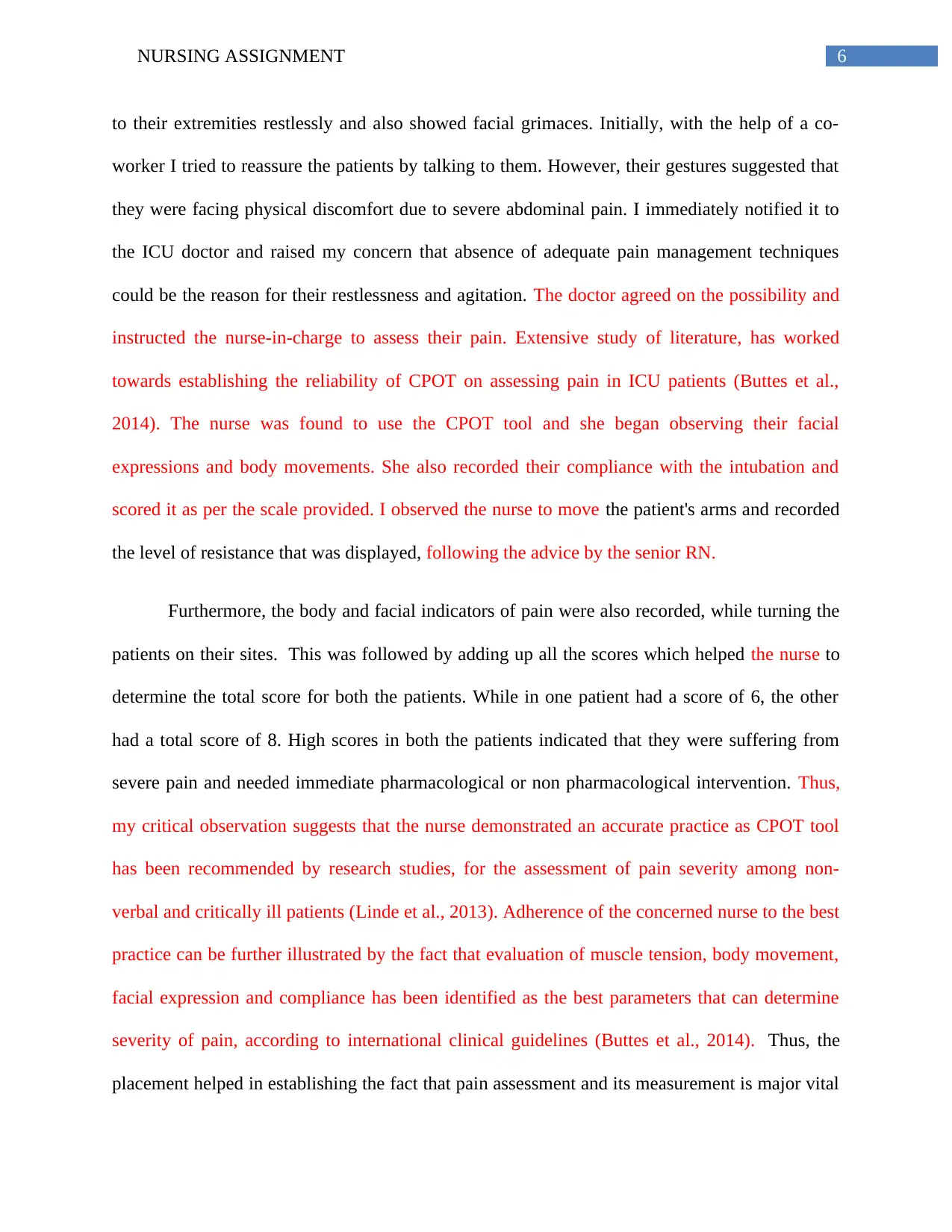
6NURSING ASSIGNMENT
to their extremities restlessly and also showed facial grimaces. Initially, with the help of a co-
worker I tried to reassure the patients by talking to them. However, their gestures suggested that
they were facing physical discomfort due to severe abdominal pain. I immediately notified it to
the ICU doctor and raised my concern that absence of adequate pain management techniques
could be the reason for their restlessness and agitation. The doctor agreed on the possibility and
instructed the nurse-in-charge to assess their pain. Extensive study of literature, has worked
towards establishing the reliability of CPOT on assessing pain in ICU patients (Buttes et al.,
2014). The nurse was found to use the CPOT tool and she began observing their facial
expressions and body movements. She also recorded their compliance with the intubation and
scored it as per the scale provided. I observed the nurse to move the patient's arms and recorded
the level of resistance that was displayed, following the advice by the senior RN.
Furthermore, the body and facial indicators of pain were also recorded, while turning the
patients on their sites. This was followed by adding up all the scores which helped the nurse to
determine the total score for both the patients. While in one patient had a score of 6, the other
had a total score of 8. High scores in both the patients indicated that they were suffering from
severe pain and needed immediate pharmacological or non pharmacological intervention. Thus,
my critical observation suggests that the nurse demonstrated an accurate practice as CPOT tool
has been recommended by research studies, for the assessment of pain severity among non-
verbal and critically ill patients (Linde et al., 2013). Adherence of the concerned nurse to the best
practice can be further illustrated by the fact that evaluation of muscle tension, body movement,
facial expression and compliance has been identified as the best parameters that can determine
severity of pain, according to international clinical guidelines (Buttes et al., 2014). Thus, the
placement helped in establishing the fact that pain assessment and its measurement is major vital
to their extremities restlessly and also showed facial grimaces. Initially, with the help of a co-
worker I tried to reassure the patients by talking to them. However, their gestures suggested that
they were facing physical discomfort due to severe abdominal pain. I immediately notified it to
the ICU doctor and raised my concern that absence of adequate pain management techniques
could be the reason for their restlessness and agitation. The doctor agreed on the possibility and
instructed the nurse-in-charge to assess their pain. Extensive study of literature, has worked
towards establishing the reliability of CPOT on assessing pain in ICU patients (Buttes et al.,
2014). The nurse was found to use the CPOT tool and she began observing their facial
expressions and body movements. She also recorded their compliance with the intubation and
scored it as per the scale provided. I observed the nurse to move the patient's arms and recorded
the level of resistance that was displayed, following the advice by the senior RN.
Furthermore, the body and facial indicators of pain were also recorded, while turning the
patients on their sites. This was followed by adding up all the scores which helped the nurse to
determine the total score for both the patients. While in one patient had a score of 6, the other
had a total score of 8. High scores in both the patients indicated that they were suffering from
severe pain and needed immediate pharmacological or non pharmacological intervention. Thus,
my critical observation suggests that the nurse demonstrated an accurate practice as CPOT tool
has been recommended by research studies, for the assessment of pain severity among non-
verbal and critically ill patients (Linde et al., 2013). Adherence of the concerned nurse to the best
practice can be further illustrated by the fact that evaluation of muscle tension, body movement,
facial expression and compliance has been identified as the best parameters that can determine
severity of pain, according to international clinical guidelines (Buttes et al., 2014). Thus, the
placement helped in establishing the fact that pain assessment and its measurement is major vital
Paraphrase This Document
Need a fresh take? Get an instant paraphrase of this document with our AI Paraphraser
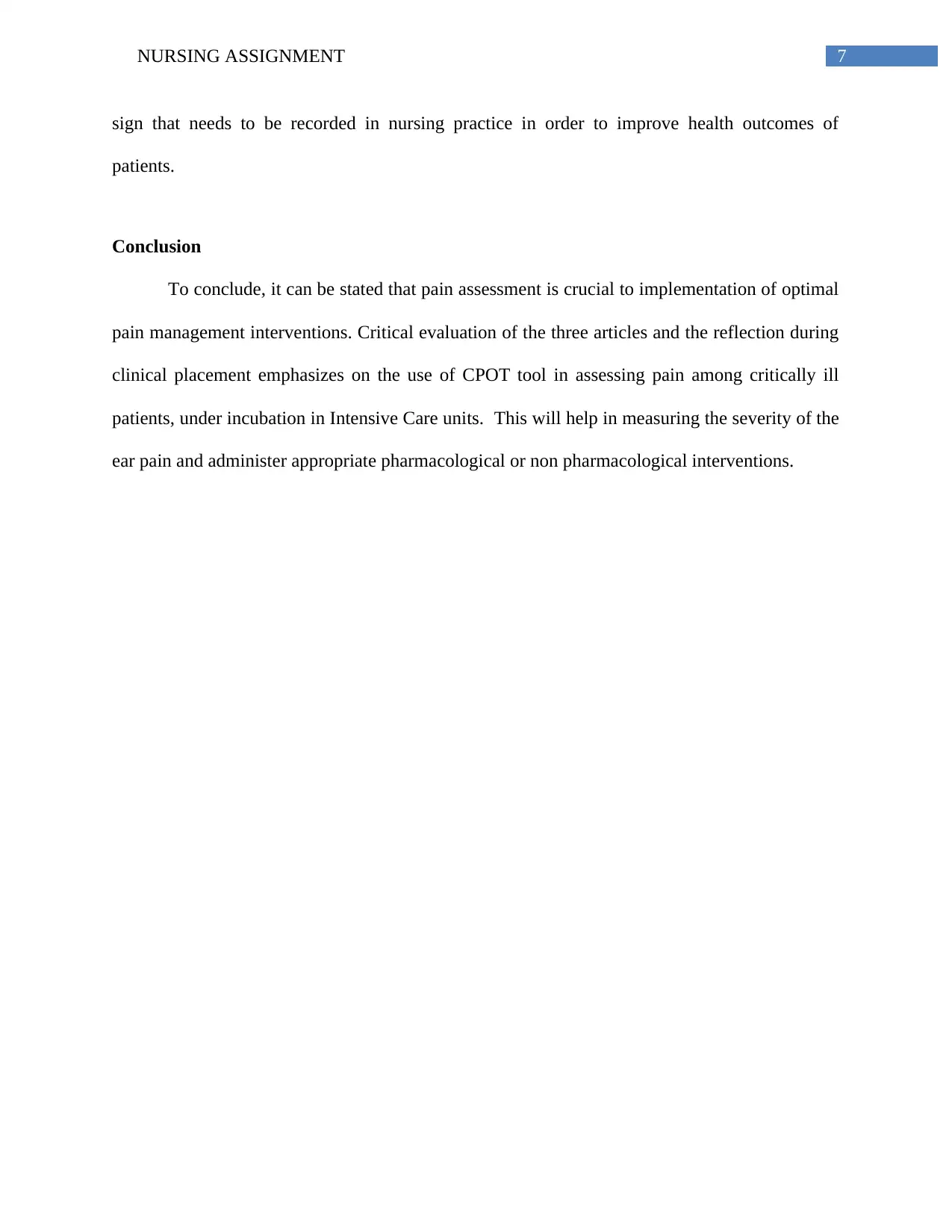
7NURSING ASSIGNMENT
sign that needs to be recorded in nursing practice in order to improve health outcomes of
patients.
Conclusion
To conclude, it can be stated that pain assessment is crucial to implementation of optimal
pain management interventions. Critical evaluation of the three articles and the reflection during
clinical placement emphasizes on the use of CPOT tool in assessing pain among critically ill
patients, under incubation in Intensive Care units. This will help in measuring the severity of the
ear pain and administer appropriate pharmacological or non pharmacological interventions.
sign that needs to be recorded in nursing practice in order to improve health outcomes of
patients.
Conclusion
To conclude, it can be stated that pain assessment is crucial to implementation of optimal
pain management interventions. Critical evaluation of the three articles and the reflection during
clinical placement emphasizes on the use of CPOT tool in assessing pain among critically ill
patients, under incubation in Intensive Care units. This will help in measuring the severity of the
ear pain and administer appropriate pharmacological or non pharmacological interventions.
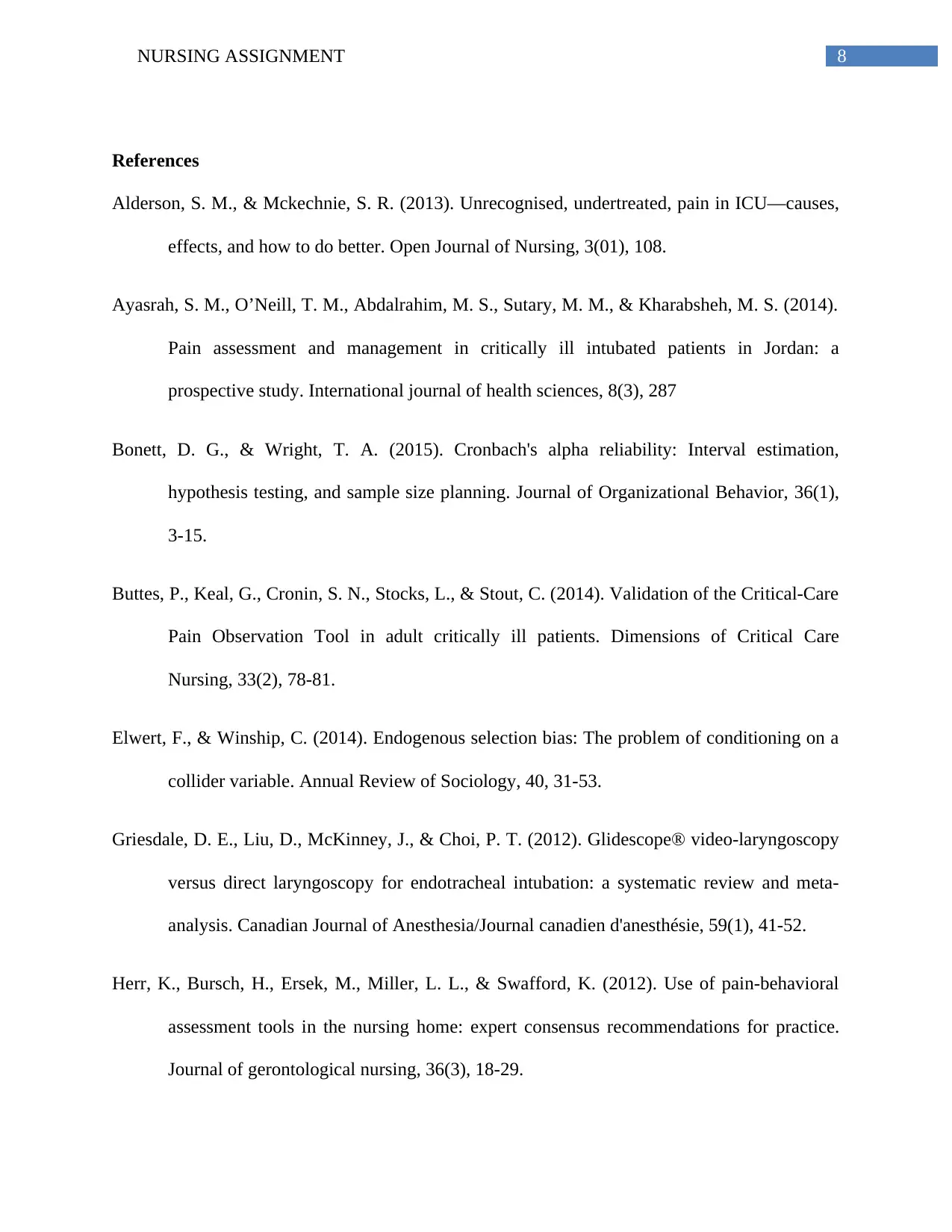
8NURSING ASSIGNMENT
References
Alderson, S. M., & Mckechnie, S. R. (2013). Unrecognised, undertreated, pain in ICU—causes,
effects, and how to do better. Open Journal of Nursing, 3(01), 108.
Ayasrah, S. M., O’Neill, T. M., Abdalrahim, M. S., Sutary, M. M., & Kharabsheh, M. S. (2014).
Pain assessment and management in critically ill intubated patients in Jordan: a
prospective study. International journal of health sciences, 8(3), 287
Bonett, D. G., & Wright, T. A. (2015). Cronbach's alpha reliability: Interval estimation,
hypothesis testing, and sample size planning. Journal of Organizational Behavior, 36(1),
3-15.
Buttes, P., Keal, G., Cronin, S. N., Stocks, L., & Stout, C. (2014). Validation of the Critical-Care
Pain Observation Tool in adult critically ill patients. Dimensions of Critical Care
Nursing, 33(2), 78-81.
Elwert, F., & Winship, C. (2014). Endogenous selection bias: The problem of conditioning on a
collider variable. Annual Review of Sociology, 40, 31-53.
Griesdale, D. E., Liu, D., McKinney, J., & Choi, P. T. (2012). Glidescope® video-laryngoscopy
versus direct laryngoscopy for endotracheal intubation: a systematic review and meta-
analysis. Canadian Journal of Anesthesia/Journal canadien d'anesthésie, 59(1), 41-52.
Herr, K., Bursch, H., Ersek, M., Miller, L. L., & Swafford, K. (2012). Use of pain-behavioral
assessment tools in the nursing home: expert consensus recommendations for practice.
Journal of gerontological nursing, 36(3), 18-29.
References
Alderson, S. M., & Mckechnie, S. R. (2013). Unrecognised, undertreated, pain in ICU—causes,
effects, and how to do better. Open Journal of Nursing, 3(01), 108.
Ayasrah, S. M., O’Neill, T. M., Abdalrahim, M. S., Sutary, M. M., & Kharabsheh, M. S. (2014).
Pain assessment and management in critically ill intubated patients in Jordan: a
prospective study. International journal of health sciences, 8(3), 287
Bonett, D. G., & Wright, T. A. (2015). Cronbach's alpha reliability: Interval estimation,
hypothesis testing, and sample size planning. Journal of Organizational Behavior, 36(1),
3-15.
Buttes, P., Keal, G., Cronin, S. N., Stocks, L., & Stout, C. (2014). Validation of the Critical-Care
Pain Observation Tool in adult critically ill patients. Dimensions of Critical Care
Nursing, 33(2), 78-81.
Elwert, F., & Winship, C. (2014). Endogenous selection bias: The problem of conditioning on a
collider variable. Annual Review of Sociology, 40, 31-53.
Griesdale, D. E., Liu, D., McKinney, J., & Choi, P. T. (2012). Glidescope® video-laryngoscopy
versus direct laryngoscopy for endotracheal intubation: a systematic review and meta-
analysis. Canadian Journal of Anesthesia/Journal canadien d'anesthésie, 59(1), 41-52.
Herr, K., Bursch, H., Ersek, M., Miller, L. L., & Swafford, K. (2012). Use of pain-behavioral
assessment tools in the nursing home: expert consensus recommendations for practice.
Journal of gerontological nursing, 36(3), 18-29.
⊘ This is a preview!⊘
Do you want full access?
Subscribe today to unlock all pages.

Trusted by 1+ million students worldwide
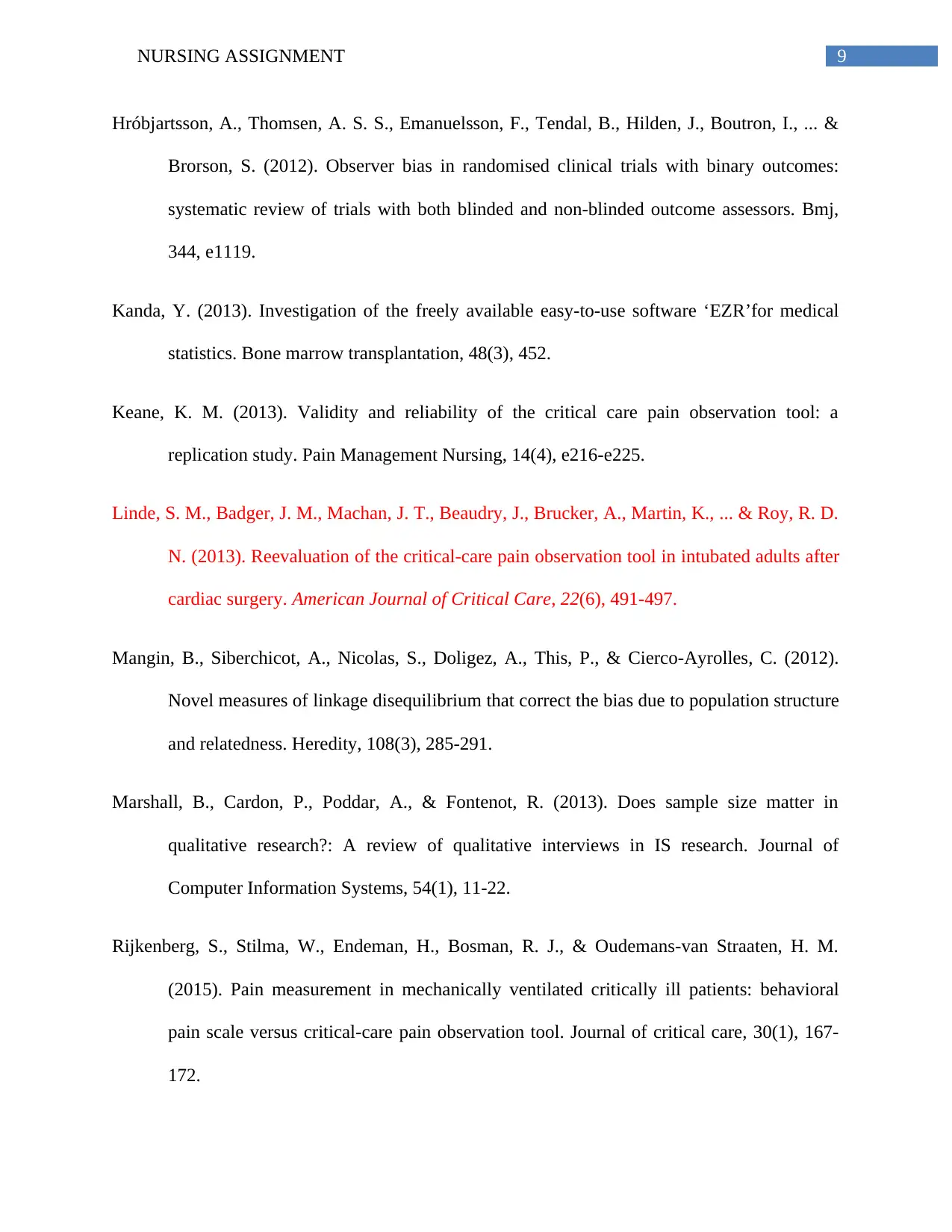
9NURSING ASSIGNMENT
Hróbjartsson, A., Thomsen, A. S. S., Emanuelsson, F., Tendal, B., Hilden, J., Boutron, I., ... &
Brorson, S. (2012). Observer bias in randomised clinical trials with binary outcomes:
systematic review of trials with both blinded and non-blinded outcome assessors. Bmj,
344, e1119.
Kanda, Y. (2013). Investigation of the freely available easy-to-use software ‘EZR’for medical
statistics. Bone marrow transplantation, 48(3), 452.
Keane, K. M. (2013). Validity and reliability of the critical care pain observation tool: a
replication study. Pain Management Nursing, 14(4), e216-e225.
Linde, S. M., Badger, J. M., Machan, J. T., Beaudry, J., Brucker, A., Martin, K., ... & Roy, R. D.
N. (2013). Reevaluation of the critical-care pain observation tool in intubated adults after
cardiac surgery. American Journal of Critical Care, 22(6), 491-497.
Mangin, B., Siberchicot, A., Nicolas, S., Doligez, A., This, P., & Cierco-Ayrolles, C. (2012).
Novel measures of linkage disequilibrium that correct the bias due to population structure
and relatedness. Heredity, 108(3), 285-291.
Marshall, B., Cardon, P., Poddar, A., & Fontenot, R. (2013). Does sample size matter in
qualitative research?: A review of qualitative interviews in IS research. Journal of
Computer Information Systems, 54(1), 11-22.
Rijkenberg, S., Stilma, W., Endeman, H., Bosman, R. J., & Oudemans-van Straaten, H. M.
(2015). Pain measurement in mechanically ventilated critically ill patients: behavioral
pain scale versus critical-care pain observation tool. Journal of critical care, 30(1), 167-
172.
Hróbjartsson, A., Thomsen, A. S. S., Emanuelsson, F., Tendal, B., Hilden, J., Boutron, I., ... &
Brorson, S. (2012). Observer bias in randomised clinical trials with binary outcomes:
systematic review of trials with both blinded and non-blinded outcome assessors. Bmj,
344, e1119.
Kanda, Y. (2013). Investigation of the freely available easy-to-use software ‘EZR’for medical
statistics. Bone marrow transplantation, 48(3), 452.
Keane, K. M. (2013). Validity and reliability of the critical care pain observation tool: a
replication study. Pain Management Nursing, 14(4), e216-e225.
Linde, S. M., Badger, J. M., Machan, J. T., Beaudry, J., Brucker, A., Martin, K., ... & Roy, R. D.
N. (2013). Reevaluation of the critical-care pain observation tool in intubated adults after
cardiac surgery. American Journal of Critical Care, 22(6), 491-497.
Mangin, B., Siberchicot, A., Nicolas, S., Doligez, A., This, P., & Cierco-Ayrolles, C. (2012).
Novel measures of linkage disequilibrium that correct the bias due to population structure
and relatedness. Heredity, 108(3), 285-291.
Marshall, B., Cardon, P., Poddar, A., & Fontenot, R. (2013). Does sample size matter in
qualitative research?: A review of qualitative interviews in IS research. Journal of
Computer Information Systems, 54(1), 11-22.
Rijkenberg, S., Stilma, W., Endeman, H., Bosman, R. J., & Oudemans-van Straaten, H. M.
(2015). Pain measurement in mechanically ventilated critically ill patients: behavioral
pain scale versus critical-care pain observation tool. Journal of critical care, 30(1), 167-
172.
Paraphrase This Document
Need a fresh take? Get an instant paraphrase of this document with our AI Paraphraser
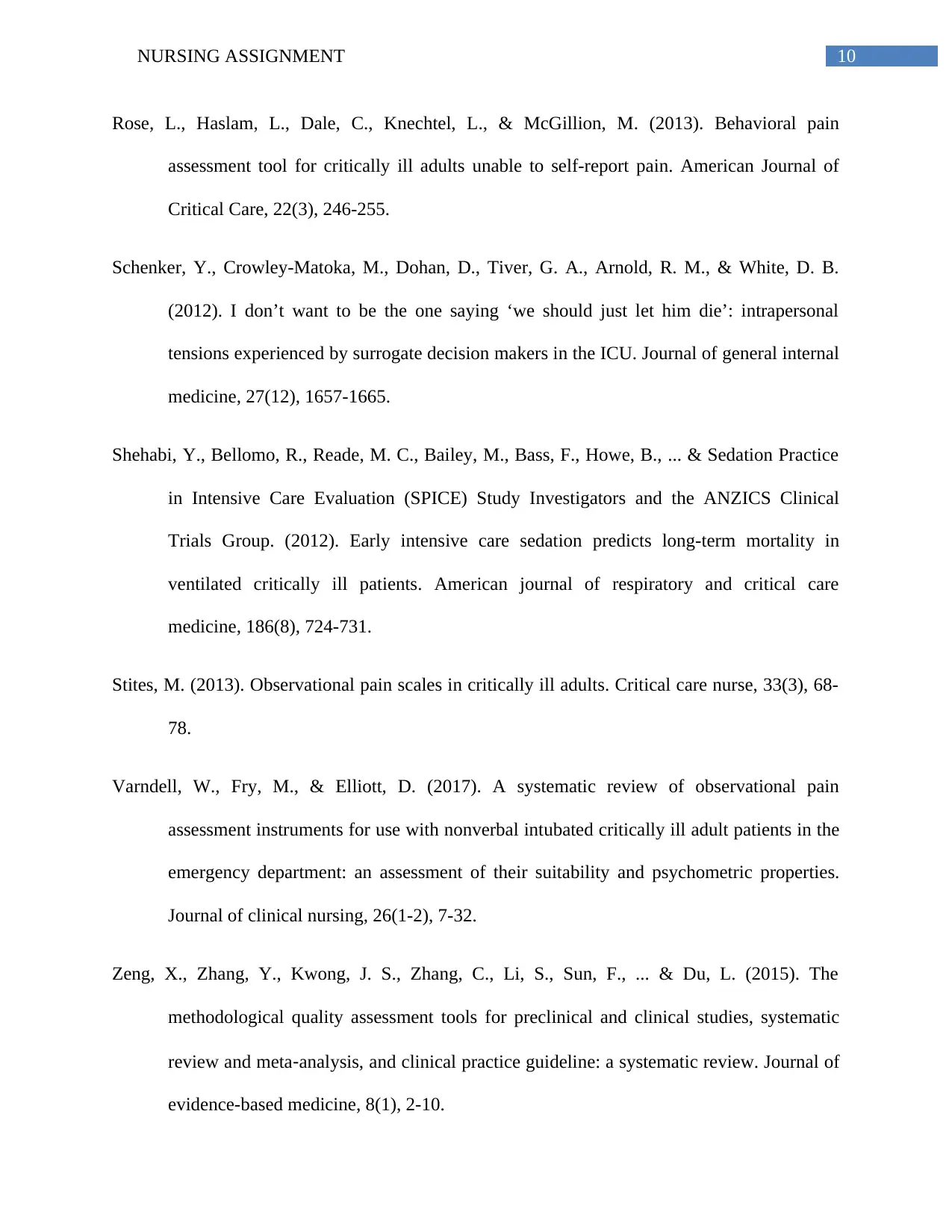
10NURSING ASSIGNMENT
Rose, L., Haslam, L., Dale, C., Knechtel, L., & McGillion, M. (2013). Behavioral pain
assessment tool for critically ill adults unable to self-report pain. American Journal of
Critical Care, 22(3), 246-255.
Schenker, Y., Crowley-Matoka, M., Dohan, D., Tiver, G. A., Arnold, R. M., & White, D. B.
(2012). I don’t want to be the one saying ‘we should just let him die’: intrapersonal
tensions experienced by surrogate decision makers in the ICU. Journal of general internal
medicine, 27(12), 1657-1665.
Shehabi, Y., Bellomo, R., Reade, M. C., Bailey, M., Bass, F., Howe, B., ... & Sedation Practice
in Intensive Care Evaluation (SPICE) Study Investigators and the ANZICS Clinical
Trials Group. (2012). Early intensive care sedation predicts long-term mortality in
ventilated critically ill patients. American journal of respiratory and critical care
medicine, 186(8), 724-731.
Stites, M. (2013). Observational pain scales in critically ill adults. Critical care nurse, 33(3), 68-
78.
Varndell, W., Fry, M., & Elliott, D. (2017). A systematic review of observational pain
assessment instruments for use with nonverbal intubated critically ill adult patients in the
emergency department: an assessment of their suitability and psychometric properties.
Journal of clinical nursing, 26(1-2), 7-32.
Zeng, X., Zhang, Y., Kwong, J. S., Zhang, C., Li, S., Sun, F., ... & Du, L. (2015). The
methodological quality assessment tools for preclinical and clinical studies, systematic
review and meta‐analysis, and clinical practice guideline: a systematic review. Journal of
evidence-based medicine, 8(1), 2-10.
Rose, L., Haslam, L., Dale, C., Knechtel, L., & McGillion, M. (2013). Behavioral pain
assessment tool for critically ill adults unable to self-report pain. American Journal of
Critical Care, 22(3), 246-255.
Schenker, Y., Crowley-Matoka, M., Dohan, D., Tiver, G. A., Arnold, R. M., & White, D. B.
(2012). I don’t want to be the one saying ‘we should just let him die’: intrapersonal
tensions experienced by surrogate decision makers in the ICU. Journal of general internal
medicine, 27(12), 1657-1665.
Shehabi, Y., Bellomo, R., Reade, M. C., Bailey, M., Bass, F., Howe, B., ... & Sedation Practice
in Intensive Care Evaluation (SPICE) Study Investigators and the ANZICS Clinical
Trials Group. (2012). Early intensive care sedation predicts long-term mortality in
ventilated critically ill patients. American journal of respiratory and critical care
medicine, 186(8), 724-731.
Stites, M. (2013). Observational pain scales in critically ill adults. Critical care nurse, 33(3), 68-
78.
Varndell, W., Fry, M., & Elliott, D. (2017). A systematic review of observational pain
assessment instruments for use with nonverbal intubated critically ill adult patients in the
emergency department: an assessment of their suitability and psychometric properties.
Journal of clinical nursing, 26(1-2), 7-32.
Zeng, X., Zhang, Y., Kwong, J. S., Zhang, C., Li, S., Sun, F., ... & Du, L. (2015). The
methodological quality assessment tools for preclinical and clinical studies, systematic
review and meta‐analysis, and clinical practice guideline: a systematic review. Journal of
evidence-based medicine, 8(1), 2-10.
1 out of 11
Related Documents
Your All-in-One AI-Powered Toolkit for Academic Success.
+13062052269
info@desklib.com
Available 24*7 on WhatsApp / Email
![[object Object]](/_next/static/media/star-bottom.7253800d.svg)
Unlock your academic potential
Copyright © 2020–2025 A2Z Services. All Rights Reserved. Developed and managed by ZUCOL.





